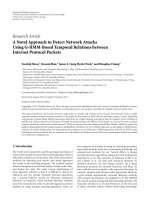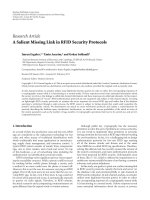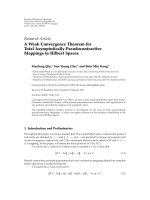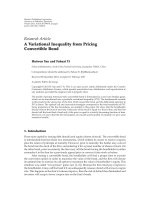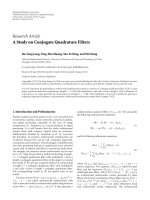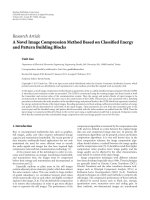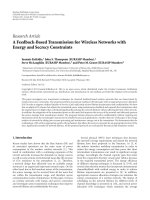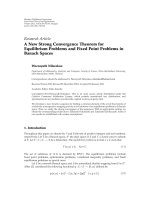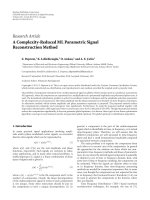Báo cáo hóa học: " Research Article A Salient Missing Link in RFID Security Protocols" potx
Bạn đang xem bản rút gọn của tài liệu. Xem và tải ngay bản đầy đủ của tài liệu tại đây (603.17 KB, 9 trang )
Hindawi Publishing Corporation
EURASIP Journal on Wireless Communications and Networking
Volume 2011, Article ID 541283, 9 pages
doi:10.1155/2011/541283
Research Article
A Salient Missing Link in RFID Securit y Protocols
Imran Erguler,
1, 2
Emin Anarim,
2
and Gokay Saldamli
3
1
National Research Institute of Electronics and Cryptology, TUBITAK, 41470 Kocaeli, Turkey
2
EE Department, Bogazici University, 34342 Istanbul, Turkey
3
MIS Department, Bogazici University, 34342 Istanbul, Turkey
Correspondence should be addressed to Imran Erguler,
Received 20 January 2011; Accepted 14 February 2011
Academic Editor: Damien Sauveron
Copyright © 2011 Imran Erguler et al. This is an open access article distributed under the Creative Commons Attribution License,
which permits unrestricted use, distribution, and reproduction in any medium, provided the original work is properly cited.
In side channel analysis, an attacker utilizes some legitimate function queries in order to collect the corresponding responses of
a cryptographic system while it is functioning in a normal mode. If those responses reveal some unwanted information about
the secrecy or privacy, this leakage is called side channel information and these responses are called side channels. In this respect,
careless deployments of “secure” RFID authentication protocols are not exceptions and subject to side channel attacks. Focusing
on lightweight RFID security protocols; we examine the server responses for several RFID tags and realize that if the database
querying is performed through a static process, the RFID system is subject to timing attacks that could easily jeopardize the
system’s untraceability criteria. We demonstrate our attack on some well-known protocols and outline a countermeasure by
precisely describing the database query mechanism. Furthermore, we analyze the success probability of the attack in terms of
the system parameters such as the number of tags, number of cryptographic operations that have to be carried out, and server’s
computational power.
1. Introduction
As a result of their low production costs and tiny size, RFID
tags are considered as the replacement technology for bar
codes and other means of traditional identification tools
which traditionally find many applications in manufactur-
ing, supply chain management, and inventory control. A
typical RFID system consists of mainly three components:
tags, one or more readers, and a back-end server. On top
of this hardware, a set of networking rules including the
authentication (or identification) protocols reside.
RFID technology raises significant privacy issues regard-
ing the traceabilit y concerns. While a person could be traced
by tracking his/her mobile phone through a carrier, such
a method is no more useful once the phone is turned off.
However, this is not the case for someone carrying an RFID
gadget. First of all, most users are not aware that they are car-
rying RFID tags. In fact, even if they know it, tags could not
be turned off in general and worse, it automatically responds
to queries via radio signals. Therefore, in RFID systems,
the attack scenarios and accompanying countermeasures are
quite different than the typical wired or wireless systems.
Although public key cryptography has the necessary
primitives to solve this sort of problems in various networks,
it is not trivial to implement these primitives in networks
having constraint devices such as RFID tags without breaking
the cost boundaries. In fact, it is a challenging task to design
authentication protocols for low-cost RFID tags resisting
all of the known attacks and threats and at the same
time fulfill the so-called RFID tag specifications. Therefore,
solving this delicate task has recently aroused the interest of
the security community, and many authentication protocols
have been proposed for RFID security. Unfortunately, most
of these, like [1–11], failed to address the requirements to a
satisfactory extent partially because of not having a common
adversary and system definitions.
In this study, our goal is to point out a salient missing link
in RFID security protocols, namely, the back-end server (or
the database) role and potential pitfalls or side channels in
RFID system realization. In side channel analysis, an attacker
utilizes some legitimate function queries in order to collect
the corresponding responses of a cryptographic system while
it is functioning in a normal mode. If those responses reveal
some unwanted information about the secrecy or privacy,
2 EURASIP Journal on Wireless Communications and Networking
this leakage is called side channel information and these
responses are called side channels. In this respect, careless
deployments of “secure” RFID authentication protocols are
not exceptions and subject to side channel attacks.
Focusing on lightweight RFID security protocols, we
examine the server responses for several RFID tags and
realize that if the database querying is performed through
a static process, the RFID system is subject to a timing
attack that could easily jeopardize the system’s untraceability
criteria. Supporting analysis and experiments of this obser-
vation are presented with the following outline. In Section 2,
after giving a brief update on related work, we describe
the basic authentication protocol (BAP) as a building block
used in describing our attack model. BAP will further be
a basis for various RFID authentication protocols that are
vulnerable to the attack. In Section 3, we present our attack
model and give probability of its success in terms of the
system parameters. Section 4 investigates security of some
RFID protocols against the proposed attack. In Section 5,we
propose solutions to fix the security flaw. Finally, we conclude
in Section 6.
2. Background
2.1. Related Work. The p otential security risks in RFID
systems hinging the differences in computation time are
mentioned in a few published work. Juels and Weis [12 ]
introduced the idea that witnessing a reader’s success in
identifying a tag could be used in distinguishing two different
tags, that is, breaking the privacy of the protocol. For
instance, opening a door with a proximity card or acceptance
of a payment card can give this information. This ability
of the adversary is also touched by Vaudenay [13] and it is
formalized in Vaudenay’s privacy model. Moreover, Juels-
Weis point that computation time of the reader can shed
critical light on protocol design and showed that O-TRAP
protocol [14] cannot provide strong privacy under this side
channel information.
In [14], Burmester et al. briefly considered timing
phenomenon by claiming: “In particular the time taken for
each pass must be constant. This can be done by inserting an
artificial delay on the trusted server”. Alternatively, Tsudik
[10] has investigated the RFID security protocols against
timing attacks targeting computations carried in the tag.
It is stated that the time variance in tag computations
corresponds to different states of the tags that might make
them distinguishable. More recently, Erguler et al. [15]and
Erguler and Anarim [16] have exploited the time differences
in reader/server responses for different tag states in order
to distinguish the tags. They have shown that two protocols
described in [17, 18] are vulnerable to such attacks.
At the time this paper was under review, Avoine et al. [19]
had extended the Vaudenay’s privacy model by formalizing
the computational time of the reader. The authors define
a new privacy level—TIMEFUL—which is determined by
leaked information from the computational time of the
reader and add this notion to the privacy levels of model
in [13]. Moreover, they present theoretical solutions to
the time problem by assigning boolean decisions about
TIMEFUL-PRIVACY of a protocol. However, the parameters
that may affec t the success of the adversary, such as precision
of reader time measurement, have been addressed as an
engineering problem.
In this paper, we present the actual implementation
results and probabilistic analysis for successful timing attack.
To be more precise, we give the success probability of the
attack in terms of the system parameters such as the number
of tags, number of cryptographic operations that have to be
carried out, and server’s computational power.
2.2. Notation and the BAP. In general, an RFID mutual
authentication protocol requires at least three rounds: the
reader initiates the communication (Round 1), the tag
produces a challenge and sends it to the reader (Round 2),
and the reader replies to the challenge (Round 3). In most
lightweight RFID authentication protocols, including [1–3,
5, 20–29] (Weis et al.’s the randomized access control scheme
[20] performs an exhaustive search in identification of the
tag), the server could need to query its entire database in
order to authenticate responder tag in Round 2. In fact, this
should not be confused w ith the simple database search since
this querying corresponds to a cryptographic exhaustive
search where every single query needs a cryptographic
operation having a nontrivial time complexity. Therefore, the
time complexity of the authentication phase becomes linear
in time (i.e., O(N)whereN denotes the number of tags in
the system). We define these systems as follows.
Definition 1. An RFID system is called linear-time authen-
tication system denoted with LAS if its server performs an
exhaustive search to identify or authenticate a tag.
In order to measure the running time differences for
different tag searches, it is sufficient to have an exhaustive
search process which is identical for each search instance.
In fact, for some cases it is possible to achieve some side
channels even if the processes are not identical. However, we
keep these cases out of our scope and formally define the
exhaustive search process as follows.
Definition 2. Let P be the item to be searched, let
S be the
set of the search space, and let (C
t
) ={c
1
, c
2
, , c
t
, } be a
sequence on
S (i.e., (C
t
):N → S). If (C
t
) is one-to-one on S
and C
t
= 0fort>N, then we call (C
t
) the query sequence
for P.
Note that the query sequence gives the order of the
exhaustive search process. For instance, the query sequence
having the general term C
t
= t for t ∈ N with the initial
condition c
1
= 1 clearly gives the standard exhaustive search
process as shown in Figure 1. If this is taken as the process
for every search item P, it would be possible to compare the
measurements of search time differences.
Definition 3. AnLASRFIDschemeissaidtobestaticlinear-
time authentication system represented as SLAS if the query
sequence for all searched items is identical.
It is equivalent to say that for an SLAS RFID scheme, in
tag identification/authentication step the order for choosing
EURASIP Journal on Wireless Communications and Networking 3
the candidates amongst the whole database is the same
for all sessions. As the number of tags in the system
increases, variance in elapsed time of the reader responses
corresponding to the different RFID tags can be measurable
for an SLAS RFID scheme. If an adversary is able to access
this time difference (an adversary may know the amount
of time spent for the tag authentication procedures on the
server by simply measuring the elapsed time between the
tag’s authentication request and its response from the server.
Note that this may not be a challenge response; it may be the
protocol payload showing whether the server is succeeded or
not, in identifying a legitimate tag), then this information
will be used as a tool to trace the tags in our attack
model.
2.3. BAP. BAP is a generic challenge response authentication
protocol used as a basis for most of the RFID authentication
protocols. We use the following notations:
T : RFID tag or transponder ,
R:RFIDreaderortransceiver,
DB: The back-end server,
ID: Identity of a tag,
r
R
:RandomnoncegeneratedbyreaderR,
r
T
: Random nonce generated by tag T ,
Δ: Elapsed time between 2nd and 3rd message flow,
N:Numberoftags,
H(): One-way hash function.
A step by step description of the BAP that satisfies the
LASpropertiesisgivenbelow.
Step 1. R challenges T with a random nonce r
R
.
Step 2. T chooses a random nonce r
T
and computes M
1
=
f
K
(r
R
, r
T
), where K is the secret information and different
for each tag and f () is a symmetric cryptogr aphic operation.
Then it transmits the result with r
T
to R.
Step 3. R delivers the messages from T to DB with r
R
.
Step 4. DB maintains a list of pairs (ID; K
i
) and identifies T
by performing an exhaustive search of all stored tag records
by computing M
1
= f
K
i
(r
R
, r
T
) for each stored ID
i
in turn,
until it finds a match with M
1
.Ifamatchisfound,DB
regards the ID as the identity of T .
Step 5. R replies to challenge of T .
Note that throughout this text, BAP will be used in
description of our attack model and will be a basis for many
RFID authentication protocols that are vulnerable to the
attack.
3. The Timing Attack
Timing attacks provide an attacker with secrets maintained
in a security system by measuring the time it takes the system
to respond to various queries. For instance, Kocher [30]
Process
C
t
= t
Database
k
i
Yes
No
Tag
response
m
Query i
Return ID
Check if
f
k
i
(m) ≥ ID
i
Figure 1: Standard exhaustive search having the general term C
t
=t.
designed a timing attack to recover secret keys used for RSA
decryption. In addition, Brumley and Boneh presented a
timing attack on unprotected OpenSSL implementations and
showed that such attack was practical, that is, an attacker
could measure the response-time variances of a secure Web
server and could derive that servers RSA private key [31].
With a similar approach, since in different steps of the RFID
protocols, tags, and the server execute different processes,
if time taken to execute these steps differs based on the
input of tags’ state or responses, an attacker can attempt to
mount a timing attack to distinguish the tags by analyzing the
time variances corresponding to their input. So, with precise
measurements of the time difference, an attacker can easily
trace the tags and break the untraceability property of the
protocol.
Intuitively, a protocol satisfies untraceability if an adver-
sary is not able to recognize a previously observed tag [32].
Untraceability issue has been treated formally in different
security models, notably driven by Avoine in [33], by
Vaudenay in [13], by Van Le et al. in [34], by Juels and
Weis in [12], and by Deursen et al. in [35]. The Juels-Weis
model characterizes a very st rong adversary with a relatively
simple definition and according to this model untraceability
is defined in terms of privacy experiments by which an
adversar y could distinguish two different tags within the
limits of its computational power and functionality-call
bounds. Throughout this text, we adopt the terms and
notions of [12] to our needs. In this privacy model, two
of the available functions for an adversary are ReaderInit
and TagInit. When receiving a ReaderInit message, R
initializes a new session and returns the first challenge of an
interactive challenge-response protocol. On the other side,
by receiving TagInit message a tag T is involved in the
4 EURASIP Journal on Wireless Communications and Networking
corresponding protocol session and it may respond to a
protocol message or challenge. For an RFID system S, the
privacy experiment, Exp
priv
S
, consists of the following two
phases:
(1) Learning Phase. in this phase, according to Juels-Weis
privacy model [12], an adversary A might initiate
a communication with the reader R (ReaderInit)
or a tag T (TagInit). Also, A has the ability to
modify, insert, or delete messages that agree with the
corresponding protocol’s procedures. In other words,
A controls the communication channel between
R and each T and may make any ReaderInit
or TagInit calls in any interleaved order without
exceeding its parameter bounds.
(2) Challenge Phase. in this phase, the adversary A selects
two tag candidates T
0
and T
1
and tests these with
the identifers ID
0
and ID
1
, respectively. Depending
on a randomly chosen bit b
∈{0, 1}, A is given
a challenger identifier ID
b
from the set {ID
0
,ID
1
}.
That is, A is given access to one of these tags
randomly, called T
b
. The adversary might again
interact with the reader and the tags. Eventually, at
some point, A decides to terminate the exper i ment
and returns the bit
b as its guess for the value of b.The
success of A in guessing b is equivalent to its success
of breaking the untraceability, and is quantified as
A’s advantage in distinguishing the tag’s identity
compared to random selection. This is expressed
formally as:
Adv
Exp
A,S
(
k
)
=
Pr
b = b
−
1
2
,(1)
where k is the security parameter (i.e., the bit length of the
unknown secret ID). An RFID system, S, achieves untrace-
ability if Adv
Exp
A,S
(k)<ε(k) for some negligible function ε().
It is equivalent to say that an attack is successful in tracing
the tags if the adversary has a nonnegligible advantage in
guessing the selected tag. As an illustrative example, assume
that the probability of a correct guess is 1/2(i.e.,Pr[
b = b] =
1/2). In this case, Adv
Exp
A,S
(k) is zero. Thus, the adversary, A,
does not have any advantage in guessing b.
Definition 4. Let γ denote the attacker’s precision in distin-
guishing elapsed time of the reader responses and expressed
in terms of seconds, that is, timing resolution.
In our attack model, we suppose the examined protocol
is based on SLAS BAP which we call SBAP and for the privacy
experiments, the adversary can follow the steps below.
In the learning phase, two tags T
0
and T
1
are randomly
selected and then the adversary obser ves successful authen-
ticated protocols between the reader and the tags and notes
respective elapsed time of the reader responses as Δ
0
and Δ
1
.
Learning Phase
(1) A randomly chooses a pair of distinct tags T
0
and T
1
.
(2) A initiates communication with R using Read-
erInit and gets r
R
0
.
(3) A initiates communication with T
0
using TagInit.
(4) A transmits r
R
0
to T
0
.
(5) A delivers T
0
response to R.
(6) A measures elapsed time, Δ
0
, between 2nd and 3rd
message flow.
(7) A initiates communication with R using Read-
erInit and gets r
R
1
.
(8) A initiates communication with T
1
using TagInit.
(9) A transmits r
R
1
to T
1
.
(10) A delivers T
1
response to R.
(11) A measures elapsed time, Δ
1
, between 2nd and 3rd
message flow.
Notice that in our attack, A always provides an answer.
Thus in the challenge phase, if
|Δ
0
− Δ
1
| <γ,hemakesa
random guess for the selected tag T
∗
b
. On the other hand,
if
|Δ
0
− Δ
1
|≥γ, the adversary only observes a successful
authentication between the legitimate reader and the selected
tag and records time duration between the second and the
third message flow, call it Δ
∗
.IfΔ
∗
≈ Δ
0
, the challenge tag is
T
0
; otherwise the selected tag is T
1
.
Challenge Phase
(i) If
|Δ
0
− Δ
1
| <γ, then A randomly flips a coin for the
value of b.
(ii) If
|Δ
0
− Δ
1
|≥γ, then:
(1) A takes T
0
and T
1
as its challenge candidates.
(2) A initiates communication with R using Read-
erInit and gets r
R
.
(3) A transmits r
R
to the selected tag T
∗
b
.
(4) A delivers T
∗
b
response to R.
(5) A measures elapsed time, Δ
∗
,between2ndand
3rd message flow.
(6) If Δ
∗
≈ Δ
0
, A guesses b = 0 and decides T
∗
b
=
T
0
; otherwise, it guesses T
∗
b
= T
1
.
Lemma 1. Suppose in exhaustive s earch of database for each
item m, cryptographic operations are evaluated and each
operation can be carried out in β seconds. Let n denote the
maximum index difference of two candidate elements c
x
and
c
y
of the query sequence (C
t
), related to the tags T
i
and T
j
,
respectively, such that the adversary cannot distinguish the tags
by using the above attack. It is equivalent to say that
n max
x,y∈[1,N]
x − y
such that c
x
= item
i
, c
y
= item
j
,
Adv
Exp
A,SBAP
(
k
)
<ε
(
k
)
.
(2)
Then we can express n
=γ/m · β.
EURASIP Journal on Wireless Communications and Networking 5
Proof. If
|Δ
i
− Δ
j
| <γ, then the A cannot realize time
difference, and so does not have a nonneg l igible advantage
in distinguishing the tags. We know that
|Δ
i
− Δ
j
|=|x −
y|·m · β,so|x − y|·m · β<γmust be satisfied to give a
negligible advantage to the adversar y. Hence the maximum
index difference n can be expressed as
n
=
γ
m · β
. (3)
Definition 5. For privacy experiment Exp
z
,supposeT
i
and T
j
are selected and c
x
= item
i
, c
y
= item
j
denote the respective
candidates in the exhaustive search process. Then the discrete
random variable Q
Exp
z
, describing the probability of being
|x− y| >n, that is, A can sense the time difference, is defined
as below
Q
Exp
z
=
⎧
⎨
⎩
1, if
x − y
>n,
0, otherwise.
(4)
Proposition 1. If N denotes number of tags in the database,
then for any selected tags T
i
and T
j
,theA’s advantage by
considering the des cribed attack is expressed as
Adv
Exp
A,SBAP
(
k
)
=
1
2
⎡
⎣
1−
1
N
N
i=1
min
(
i − 1, n
)
+min
(
N − i, n
)
N − 1
⎤
⎦
.
(5)
Proof. Success probability of the attack depends on
Pr[Q
Exp
= 1]. If Q
Exp
= 0, that is, |x − y|≤n, the
adversary has zero advantage since he could just as well
have flipped a coin to make the guess, which would have
given him the same probability of correct guessing. On the
other hand if Q
Exp
= 1, he can recognize the time difference
of the reader responses and makes a correct guess for the
privacy experiment with maximum advantage. Therefore,
the correct guess probability can be expressed as
Pr
b = b
=
∀a∈{0,1}
Pr
b = b | Q
Exp
= a
×
Pr
Q
Exp
= a
=
Pr
b = b | Q
Exp
= 0
×
Pr
Q
Exp
= 0
+Pr
b = b | Q
Exp
= 1
×
Pr
Q
Exp
= 1
.
(6)
ThemarginalprobabilitiesofPr[Q
Exp
]isderivedas
follows:
Pr
Q
Exp
=
⎧
⎪
⎪
⎪
⎪
⎪
⎪
⎪
⎪
⎪
⎪
⎪
⎪
⎪
⎨
⎪
⎪
⎪
⎪
⎪
⎪
⎪
⎪
⎪
⎪
⎪
⎪
⎪
⎩
Pr
Q
Exp
= 0
=Pr
x − y
≤
n
=
1
N
N
i=1
min
(
i − 1, n
)
+min
(
N − i, n
)
N − 1
,
Pr
Q
Exp
= 1
=
1 − Pr
Q
Exp
= 0
=
1−
1
N
N
i=1
min
(
i−1, n
)
+min
(
N − i, n
)
N − 1
.
(7)
1000 2000 3000 4000 5000 6000 7000 8000 9000 10000
0.3
0.35
0.4
0.45
0.5
Advantage of adversary
n
N
= 50000
N
= 100000
N
= 250000
N
= 500000
N
= 1000000
Figure 2: Advantage of the adversary for different n and N.
Notice that Pr[
b = b|Q
Exp
= 1] = 1andPr[
b = b|Q
Exp
=
0] = Pr[random coin flip] = 1/2. Thus, if we replace these
values together with those given in (7)in(6), we obtain
Pr
b = b
=
1 −
1
2N
N
i=1
min
(
i − 1, n
)
+min
(
N − i, n
)
N − 1
.
(8)
From (1)weobtain
Adv
Exp
A,SBAP
(
k
)
=
1
2
⎡
⎣
1 −
1
N
N
i=1
min
(
i−1, n
)
+min
(
N − i, n
)
N − 1
⎤
⎦
.
(9)
In Figure 2 , advantage of the adversary for different n and
N values is shown. Note that as N
n,Adv
Exp
A
(k)becomes
closer to 1/2, which is the maximum advantage.
Remark 1. Since 2n/N > 2n/(N
− 1) > 1/N
N
i
=1
((min(i −
1, n)+min(N − i, n))/(N − 1)), Adv
Exp
A,SBAP
(k) > 1/2 − n/N.
Therefore, for N
n, advantage of an adversary can be
approximated as
Adv
Exp
A,SBAP
(
k
)
≈
1
2
−
n
N
.
(10)
In order to illustrate the realization of the presented
attack, we consider a real life scenario in a library, where tags
are used to identify books and the protocol is an SBAP.
Example 1. We consider an SBAP RFID scheme installed in a
public library to substitute bar codes on the books. Suppose
the library has got about 1 million of books, N
= 1 000000,
and we assume that there are about 100000 candidates
between c
x
and c
y
as the candidates related to some books
6 EURASIP Journal on Wireless Communications and Networking
book
i
and book
j
, respectively, in the database, that is,
|x − y|=100000. Besides, we suppose that timing resolution
of an adversary who attempts to apply the proposed attack
is one millisecond and also to identify a single tag the server
needs a single cryptographic operation which is performed
in one microsecond. Thus, β
= 10
−6
, γ = 10
−3
,andm = 1.
In the light of given information, it is obvious that book
i
identification process will be faster than those of book
j
’s.
Moreover, by using (3)weobtainn
= 1000. Because n<
|x − y|=100000, the adversary can easily distinguish these
two tags by comparing the elapsed time between 2nd and 3rd
rounds of the protocols for each tag.
4. Analysis of Some RFID Schemes
In this section, we examine some RFID privacy schemes
proposed in the literature: Those of Song and Mitchell (SM)
[5], a challenge/response-based protocol by [3], the scheme
of Duc et al. [22], and the model proposed by Ohkubo et al.
(OSK) [2]. In our analysis, we do not consider whether
or not these protocols have been cryptanalyzed previously
by some different type attacks like denial of service, tag
impersonation, replay attacks, or others; rather we focus on
realization of our attack for these schemes. The common
point of these models is that how the candidates are chosen
from database in the search process is not defined exactly,
and this makes them vulnerable against our attack. In the
following parts, we assume that the system relies on a
single computer which takes 2
−20
seconds to carry out a
cryptographic operation, that is, β
= 2
−20
, the number of
tags in the system, N,is2
20
and γ = 2
−10
seconds (i.e.,
≈1 ms), unless otherwise is stated. Furthermore, below we
only give the three message flows of the protocol since these
parts interest us. Update of the secrets and other details can
be found in the corresponding study.
4.1. The SM Protocol and Analysis. Song and Mitchell
proposed an RFID authentication protocol in [5]. In this
scheme, a server stores secrets u
i
and t
i
for each tag T
i
as
well as the most recent secrets
u
i
and
t
i
. Initially, secret u
i
is a string of l bits assigned to T
i
,andt
i
= H(u
i
). Firstly,
the reader sends a random bit-string r
1
to the tag. The tag
generates a random bit-string r
2
, computes two messages
M
1
= t
i
⊕ r
2
and M
2
= f
t
i
(r
1
⊕ r
2
), where f is a keyed
hash function, and sends (M
1
, M
2
) back to the reader. The
reader delivers (r
1
, M
1
, M
2
) to the back-end server for tag
authentication. The server will search in its database for a
record (u
j
, t
j
)or(u
j
,
t
j
) such that M
2
= f
t
j
(r
1
⊕ M
1
⊕ t
j
).
If a match is found, the server computes r
2
= M
1
⊕ t
j
,and
then computes M
3
= u
j
⊕ (r
2
l/2). Finally, the reader
forwards M
3
to tag.
The steps of our attack described in Section 3 can be
directly applied on SM protocol. In exhaustive search process
for each candidate, two cryptographic operations, f
t
j
(r
1
⊕
M
1
⊕t
j
)and f
t
j
(r
1
⊕M
1
⊕
t
j
), are executed, so m = 2. By using
(3), we obtain n
= 512. Also from (9), Adv
Exp
A,SM
(k) = 0.4995
is computed.
Besides, in [29] an improvement to SM protocol is
proposed and to the best of our knowledge it has received
no attacks yet. However, same weakness also exists in this
protocol and it can be easily broken with our attack.
4.2. The Rhee’s Protocol and Analysis. A challenge-response
authentication protocol based on a hash function is proposed
in [3]. The scheme is vulner a ble to our attack as the
back-end database is required to perform an ID search to
find the specific information related to the tag requesting
authentication. The protocol c an be summarized as follows.
The reader transmits Query and a random number
R
reader
. The tag generates a random number R
tag
,computes
H(ID
R
reader
R
tag
) generated by itself, and sends the result
with R
tag
to the reader. The reader delivers the tag’s response
to the back-end server. Next, for each ID stored in the back-
end database, the back-end database concatenates ID, R
reader
,
and R
tag
then hashes it and checks whether or not it is
equal to hash result obtained from the tag to authenticate
it. The search process continues till a match is found. If
the authentication is successful, the back-end database sends
H(ID
R
tag
) to the reader and the reader forw ards it to the
tag.
In the brute force search of server for each candidate, one
cryptographic operation is done, so m
= 1. If we replace the
values in (3), we get n
= 1024 and this leads to Adv
Exp
A
(k) =
0.499 for our attack.
4.3. The Duc et al.’s Protocol and Analysis. In [22], a
challenge-response protocol for RFID was proposed by
Duc et al. According to the protocol, the server stores the
following values for each tag: EPC
i
, tag’s access pin PIN
i
and the tag key K
i
. We can briefly describe the steps of the
protocol as given below.
The reader firstly queries a request to tag. The tag gener-
ates a random number r,computesM
1
= CRC(EPC
i
r)⊕K
i
and C = CRC(M
1
⊕ r). Then the tag sends the values
(M
1
, C, r) back to the reader, which will forward these values
to the server, where EPC
i
is electronic product code and CRC
stands for cyclic redundancy code. For each tuple (EPC
i
, K
i
)
in back-end database, the server verifies that M
1
⊕ K
i
equals
CRC(EPC
r)andC = CRC(M
1
⊕ r). If it can find a match,
then the tag is successfully identified and authenticated. Next,
the server computes M
2
= CRC(EPC
i
PINr)⊕K
i
and sends
M
2
to the tag through the reader.
Now let us apply the proposed attack on Duc et al.’s
protocol. Since CRC computation consumes less time than
hash or other symmet ric encryption, we assume server
can evaluate a CRC operation in 2
−28
seconds so β =
2
−28
. Moreover, for each entry from database, one CRC is
calculated; m
= 1. For these values, n = 2
18
is evaluated and
from (9)itmeansAdv
Exp
A
(k) = 0.28 for our attack.
4.4. The OSK Protocol and Analysis. The protocol proposed
in [2] relies on hash chains. When a tag is queried by a
reader, it sends a hash of its current identifier with H
1
and
then updates it using a second hash function H
2
.Eachtag
stores in its memory a random identifier s
1
i
. The message
flows of the protocol can be depicted as follows: the reader
EURASIP Journal on Wireless Communications and Networking 7
Table 1: The configuration used in the experiments.
Operating system Windows XP SP3
CPU Intel Core2 Quad Q8300
Compiler MS Visual C#
Cryptographic library .net System.Security.Cryptography
sends an identification request to the tag and receives back
r
k
i
= H
1
(s
k
i
)wheres
k
i
is the current identifier of the tag.
Then tag replaces s
k
i
by s
k+1
i
= H
2
(s
k
i
). On the server side,
from r
k
i
, the system identifies the corresponding tag. In order
to do this, it constructs the hash chains from each N initial
value until it finds the match with r
k
i
or until it reaches a
given maximum limit δ on the chain length. The threshold δ
is the number of read operations on a single tag between two
updates of the database. A suited size for δ could be 128 as
mentioned in [36].
Notice that OSK protocol does not exactly fit to the
steps of BAP, because after identification of the tag, the
reader does not send any message to the tag. Hence, how
we can apply the proposed attack on OSK could arise in
our minds. Although the reader does not respond in the
third message flow, as presented in [12] the adversary can
record the elapsed time till tag identification is realized by
observing a validation event. For example, opening a door
with a proximity card or acceptance of a payment card can
be used as validation events. Nevertheless, one can argue
that the work of attacker is more difficult than the cases of
previous protocols. Therefore, we assume that the attacker’s
time distinguishing capability may be lower and set γ
= 1
seconds. In addition, according to OSK protocol for each
trial, 2 δ hash operations are computed. For δ
= 128, we
get m
= 256, and by using (3), n = 4096 is evaluated. As
a result, from the equation for advantage of the adversary
Adv
Exp
A,OSK
(k) = 0.496 is obtained.
4.5. Experimental Results. We experimentally examine the
capabilities of the proposed timing analysis by implementing
the Rhee’s and Duc et al.’s protocols. These are chosen
for simplicit y though similar experimental result can be
achieved for other mentioned protocols in this section.
The source code was compiled using the MS Visual C#
compiler with default optimizations. All of the experiments
were run under the configuration shown in Tab le 1. We used
random keys generated by .net System.Random class key
generation routine. We measured the time using stopwatch
class and take the averages in order to measure elapsed time
accurately.
In the implementation of Rhee’s protocol, we use the
standard SHA-1 in MS .net System.Security.Cryptography
class where we write a custom class for CRC implementation
used in Duc et al.’s protocol. Our CRC routine uses a lookup
table which reflects the lightweight feature of the protocol
as it outperforms the SHA-1 implementation. In Tables 2
and 3, timings for exhaustive search steps of the protocols
are tabulated, where “index difference” stands for
|x − y|
as mentioned in Lemma 1. As formulated in the previous
Table 2: Timing attack on Rhee’s protocol [3].
Index difference Δ time
500 12 ms
1000 27 ms
10 K 298 ms
100 K 3033 ms
500 K 14852 ms
1 M 29780 ms
Table 3: Timing attack on Duc et al.’s protocol [22].
Index difference Δ time
500 0.7 ms
1000 1.1 ms
10 K 20 ms
100 K 97 ms
500 K 417 ms
1 M 807 ms
section, timing attacks could be very powerful in case a poor
search process is chosen.
5. Countermeasures
Before giving our countermeasure against the proposed
attack, we want to elaborate on some other obvious but not
efficient techniques that remedy the security flaw.
With consideration of the previous parts, intuitively one
can provide security against the proposed timing attack by
realizing the condition that the server response time var ia-
tion for different tags is negligible, in other words, the server
responds with an equal time and this is same for all tags.
This condition can be achieved by using look-up tables as
mentioned in [19] or artificially padding the delay in reader
responses for all tags as reported in [14]. For the lookup-
table model the server stores all possible answers of tags that
are precomputed prev iously. Thus, in authentication phase
the server avoids to make an exhaustive search, and instead
responds in constant-time. Note that although this solution
fixes the problem, constructing such a scheme with satisfying
security and implementation requirements is impractical. In
fact, if such a system exists, then clearly the use of exhaustive
search in tag identification would be abandoned. On the
other hand, inserting an artificial delay at the server side,
determined by the worst case time, definitely eradicates the
security flaw. However, this is clearly undesirable, because it
reduces the efficiency of the overall system.
Our timing analysis and the experimental results of
the previous section exploit the use of an SLAS RFID
scheme which uses a static exhaustive search process on
server authentication. However, if a dynamic search process
is employed the described timing analysis would fail in
measuring the running time differences for different tag
searches. In this respect, the simplest countermeasure to
avoid such attacks would be simply changing the starting
8 EURASIP Journal on Wireless Communications and Networking
point of the exhaustive search process. We formulate this
countermeasure as follows.
Countermeasure 1. Let an RFID system implements an SLAS
scheme, having the same query sequence (C
t
)forallofits
search items such as
{P
0
, P
1
, , P
l
} for some positive integer
l. Choosing nonidentical random query sequences (C
t
)for
all search items gives the desired protection for the described
attacks.
Although Countermeasure 1 gives a wide range of selec-
tion having different implementation complexities, naturally,
the simplest countermeasures come from setting minimal
differences between query sequences. Observe that query
sequences (C
t
) can also be seen as permutations on N items
where N is the number tags. Thus, composing the query
sequences with the following constant cyclic permutation π
j
gives nonidentical shifted query sequences:
π
j
(
i
)
=i+r
j
mod N, for random r
j
, j =0, 1, , l,0<i≤ N.
(11)
In other words, for all search items
{P
0
, P
1
, , P
l
} we have
the following general terms for the corresponding query
sequences
C
π
j
(t)
,forj = 0, 1, , l.
(12)
In fact, this modification corresponds to random selec-
tion of the starting point of the exhaustive search process.
Since we use different query sequences for different tag
searches, for any selected two tags the index difference will
also be different. Therefore, timing attacks would fail in
measuring the time differences.
6. Conclusion
It is shown that exhaustive search process is crucial in
RFID authentication protocols. Although the protocol might
satisfy the necessary security requirements of the RFID sys-
tem specifications, careless deployments of database search
mechanisms could jeopardize the security of the whole
system. Therefore, it should not be left to user’s choice and
has to be described precisely in the system specifications. We
believe our attempt would point out this salient missing link
in RFID security protocols and address the potential pitfalls
or side channels in realizations.
Inordertosupportourobservationthroughacareful
analysis we give the minimum index difference of two
selected tags in database such that the attacker succeeds.
In addition, the success probability of the proposed attack
model is derived in terms of the number of tags in the
system, number of cryptographic operations carried out by
the server, the computational power of the server, and the
sensitivity of the attacker in timing.
As a countermeasure for the timing attack, we propose
a dynamic search process which would fail in measuring the
running time differences for different tag searches. We claim
that choosing nonidentical random query sequences (C
t
)for
all search items gives the desired protection for the described
attacks.
Acknowledgments
The authors would like to thank the anonymous reviewers
for their constructive comments and suggestions on this
work. Note that, G. Saldamli is partially funded by Bogazici
University BAP project No: 5721.
References
[1] H.Y.ChienandC.H.Chen,“Mutualauthenticationprotocol
for RFID conforming to EPC class 1 generation 2 standards,”
Computer Standards and Interfaces, vol. 29, no. 2, pp. 254–259,
2007.
[2] M. Ohkubo, K. Suzuki, and S. Kinoshita, “Cryptographic
approach to “privacy-friendly” tags,” RFID Privacy Work-6
shop, MIT, MA, USA, 2003.
[3] K. Rhee, J. Kwak, S. Kim, and D. Won, “Challenge-response
based on RFID authentication protocol for distributed
database environment,” in Proceedings of the International
Conference on Security in Pervasive Computing (SPC ’05),D.
Hutter and M. Ullmann, Eds., vol. 3450 of Lecture Notes in
Computer Science, pp. 70–84, Springer, Berlin, Germany, 2005.
[4] D. Nguyen Duc, J. M. Park, H. R. Lee, and K. J. Kim,
“Enhancing security of EPCglobal Gen-2 RFID tag against
traceability and cloning,” in Proceedings of the Symposium
on Cryptog raphy and Information Security, Hiroshima, Japan,
January 2006.
[5] B. Song and C. J. Mitchell, “RFID authentication protocol
for low-cost tags,” in Proceedings of the ACM Conference
on Wireless Network Security (WiSec ’08),V.D.Gligor,J.
Hubaux, and R. Poovendran, Eds., pp. 140–147, ACM Press,
Alexandria, Va, USA, 2008.
[6] T. Dimitriou, “A lightweight RFID protocol to protect
against traceability and cloning attacks,” in Proceedings of
the Conference on Security and Privacy for Emerging Areas in
Communication Networks (SecureComm ’05), IEEE, Athens,
Greece, September 2005.
[7] D.HenriciandP.M
¨
uller, “Hash-based enhancement of loca-
tion privacy for radio-frequency identification devices using
var ying identifiers,” in Proceedings of the International Work-
shop on Pervasive Computing and Communication Security
(PerSec ’04), pp. 149–153, IEEE Computer Society, Orlando,
Fla, USA, March 2004.
[8] D. Molnar and D. Wagner, “Privacy and security in library
RFID: issues, practices, and architectures,” in Proceedings of the
ACM Conference on Computer and Communications Security
(CCS ’04), B. Pfitzmann and P. Liu, Eds., pp. 210–219, ACM
Press, Washington, DC, USA, October 2004.
[9] J. C. Ha, J. H. Ha, S. J. Moon, J. M. Gonzalez Nieto, and
C. Boyd, “Low-cost and strong-security RFID authentication
protocol,” in Proceedings of the EUC Workshops, vol. 4809
of Lecture Notes in Computer Science, pp. 795–807, Springer,
Berlin, Germany, 2007.
[10] G. Tsudik, “A family of dunces: trivial RFID identification and
authentication protocols,” Cryptology ePrint Archive Report
2006/015, 2007.
[11] C. C. Tan, B. Sheng, and Q. Li, “Serverless search and
authentication protocols for RFID,” in Proceedings of the 5th
Annual IEEE International Conference on Pervasive Computing
and Communications (PerCom ’07), pp. 3–12, March 2007.
[12] A. Juels and S. Weis, “Defining strong privacy for RFID,” in
Proceedings of the 5th Annual IEEE International Conference on
Pervasive Computing and Communications (PerCom ’07),pp.
342–347, 2007, Full version available at IACR ePrint Archive.
EURASIP Journal on Wireless Communications and Networking 9
[13] S. Vaudenay, “On privacy models for RFID,” in Proceedings
of the Advances in Cryptology (ASIACRYPT ’07), vol. 4833 of
Lecture Notes in Computer Science, pp. 68–87, Springer, Berlin,
Germany, 2007.
[14] M. Burmester, T. V. Le, and B. D. Medeiros, “Provably secure
ubiquitous systems: universally composable RFID authentica-
tion protocols,” in Proceedings of the Conference on Security
and Privacy for Emerging Areas in Communication Networks
(SecureComm ’06), IEEE, 2006.
[15] I. Erguler, M. Akgun, and E. Anarim, “Cryptanalysis of
a lightweight RFID authentication protocol—LRMAP,” in
Proceedings of the Western European Workshop on Research in
Cryptology (WeWORC ’09), Graz, Austria, July 2009.
[16] I. Erguler and E. Anarim, “Scalability and security conflict for
RFID authentication protocols,” Wireless Personal Communi-
cations. In press.
[17] B. Song and C. J. Mitchell, “Scalable RFID pseudonym
protocol,” in Proceedings of the 3rd International Conference
on Network and System Security (NSS ’09), pp. 216–224, IEEE
Computer Society Press, October 2009.
[18] J. Ha, J. Ha, S. Moon, and C. Boyd, “LRMAP: lightweight
and resynchronous mutual authentication protocol for RFID
system,” in Proceedings of the International Conference on
Ubiquitous Convergence Technology (ICUCT ’07),F.Stajano,
H J. Kim, J S. Chae, and S D. Kim, Eds., vol. 4412 of
Lecture Notes in Computer Science, pp. 80–89, Springer, Berlin,
Germany, 2007.
[19] G. Avoine, I. Coisel, and T. Martin, “Time measurement
threatens privacyfriendly RFID authentication protocols,” in
Proceedings of the Workshop on RFID Security (RFIDSec ’10),
Istanbul, Turkey, June 2010.
[20] S. Weis, S. Sarma, R. Rivest, and D. Engels, “Security and
privacy aspects of low-cost radio frequency identification
systems,” in Proceedings of the International Conference on
Security in Pervasive Computing (SPC ’03),D.Hutter,G.Mller,
W. Stephan, and M. Ullmann, Eds., vol. 2802 of Lecture Notes
in Computer Science, pp. 201–212, Springer, Berlin, Germany,
2003.
[21] Y. An and S. Oh, “RFID system for users privacy protection,”
in Proceedings of Asia-Pacific Conference on Communications,
pp. 516–519, Perth, Australia, 2005.
[22] D. N. Duc, J. Park, H. Lee, and K. Kim, “Enhancing security
of EPC global gen-2 RFID tag against traceability and
cloning,” in Proceedings of the Symposium on Cryptography
and Information Security (SCIS ’06), The Institute of Electron-
ics, Information and Communication Engineers, Hiroshima,
Japan, 2006.
[23] K. Osaka, T. Takagi, K. Yamazaki, and O. Takahashi, “An
efficient and secure RFID security method with ownership
transfer,” in Proceedings of the Computational Intelligence and
Securit y (CIS ’06) , Y. Wang, Y. Cheung, and H. Liu, Eds.,
vol. 4456 of Lecture Notes in Computer Science, pp. 778–787,
Springer, Berlin, Germany, 2006.
[24] S. Lee, T. Asano, and K. Kim, “RFID mutual authentication
scheme based on synchronized secret information,” in Pro-
ceedings of the Symposium on Cryptography and Information
Securit y (SCIS ’06), The Institute of Electronics, Information
and Communication Engineers, Hiroshima, Japan, 2006.
[25] P.Peris-Lopez,J.C.Hernandez-Castro,J.M.Estevez-Tapiador,
and A. Ribagorda, “An efficient authentication protocol for
RFID systems resistant to active attacks,” in Proceedings of the
Emerging Directions in Embedded and Ubiquitous Computing
(EUC ’07), vol. 4809 of Lecture Notes in Computer Science,pp.
781–794, Springer, Berlin, Germany, 2007.
[26] S. Fouladgar and H. Afifi, “A simple privacy protecting scheme
enabling delegation and ownership transfer for RFID tags,”
Journal of Communications, vol. 2, no. 6, pp. 6–13, 2007.
[27] H. Y. Chien and C. W. Huang, “A lightweight RFID protocol
using substring,” in Proceedings of the IFIP International
Conference on Embedded and Ubiquitous Computing (EUC
’07), vol. 4808 of Lecture Notes in Computer Science, pp. 422–
431, Springer, Berlin, Germany, 2007.
[28] T. Lim, T. Li, and T. Gu, “Secure RFID identification
and authentication with triggered hash chain variants,” in
Proceedings of the 14th International Conference on Parallel
and Distributed Systems (ICPADS ’08), pp. 583–590, IEEE
Computer Society, Melbourne, Australia, 2008.
[29] S. Cai, Y. Li, T. Li, and R. Deng, “Attacks and improvements to
an RFID mutual authentication protocol and its extensions,”
in Proceedings of the 2nd ACM Conference on Wireless Network
Securit y (WiSec ’09), pp. 51–58, ACM Press, Zurich, Switzer-
land, 2009.
[30] P. Kocher, “Timing attacks on implementations of Diffie-
Hellman, RSA, DSS and other systems,” in Proceedings of
the Advances in Cryptology (CRYPTO ’96),N.Koblitz,Ed.,
vol. 1109 of Lecture Notes in Computer Science, pp. 104–113,
Springer, Berlin, Germany, 1996.
[31] D. Brumley and D. Boneh, “Remote timing attacks are prac-
tical,” in Proceedings of the 12th Usenix Security Symposium
(SECURITY ’04), pp. 1–14, Washington D C, USA, 2004.
[32]T.vanDeursenandS.Radomirovi
´
c, “Security of RFID
protocols—a case study,” Electronic Notes in Theoretical Com-
puter Science, vol. 244, pp. 41–52, 2009.
[33] G. Avoine, “Adversarial model for radio frequency identifi-
cation,” Cryptology ePrint Archieve Report 2005/049, 2005,
.
[34] T. Van Le, M. Burmester, and B. De Medeiros, “Universally
composable and forward-secure RFID authentication and
authenticated key exchange,” in Proceedings of the 2nd ACM
Conference on Computer and Communications Security (CCS
’07), pp. 242–252, Singapore, March 2007.
[35] T. V. Deursen, S. Mauw, and S. Radomirovic, “Untraceability
of RFID protocols,” in Proceedings of the Information Security
Theory and Practices. Smart Devices, Convergence and Next
Generation Networks (WISTP ’08), vol. 5019 of Lecture Notes in
Computer Scie nce, pp. 1–15, Springer, Berlin, Germany, 2008.
[36] G. Avoine, E. Dysli, and P. Oechslin, “Reducing time com-
plexity in RFID systems,” in Proceedings of the Selected Areas
in Cryptography (SAC ’05),B.PreneelandS.Tavares,Eds.,
vol. 3897 of Lecture Notes in Computer Science, pp. 291–306,
Springer, Berlin, Germany, 2005.
